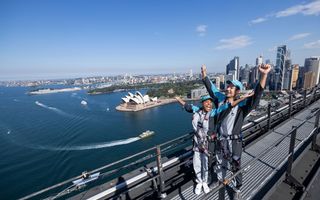China is Australia's fastest-growing international source market for inbound tourism according to data from the Australian Bureau of Statistics.
Between June 2024 and May 2025, the number of Chinese visitors arriving in Australia reached 947,600, a year-on-year increase of 21 per cent.
Last week in Shanghai, Tourism Australia launched the next chapter of its global 'Come and say G'day' campaign. The event in China kicked off a series of global campaign launches, with the campaign rolling out across key international markets over the next few months, timed to align with localised key booking periods.
The second chapter of Come and say G’day builds on the global campaign, which has been in key markets around the world since October 2022. In that time consideration for an Australian holiday has increased by 10 per cent in the United States, United Kingdom and China; while flight searches for Australia have risen by 22 per cent.

At the launch Yosh Yu was announced as the talent for the Chinese version of the campaign.
The actor has visited Australia several times and his role in the campaign will showcase the romance and lasting impact an Australian holiday has on its visitors.
Tourism Australia also welcomed him as the newest Ambassador to its Friends of Australia program during the event.
The Friends of Australia program includes ambassadors from around the world, who share their personal and authentic Australian stories to their networks as well as through Tourism Australia’s channels.
Tourism Australia is working with around 200 commercial partners, including major Chinese airlines and distribution platforms such as Trip.com Group, to support tourism recovery and the 'Come and say G’day' campaign aims to accelerate growth through emotionally resonant storytelling and market-specific content.
According to Tourism Australia Chinese visitors have pivoted from simply sightseeing in the cities to travelling all over the country.
Managing Director Phillipa Harrison said: "Chinese travellers are now going outside of the cities as well.
"They hire cars and go into regional areas—that's the case even for first-time visitors.
"Also, with the number of travellers in their 20s increasing, we see these younger individuals seeking more adventure-based programs. They go out to the mountains, go diving and go hiking, among other activities, which also makes their stay in the country slightly longer than before."
According to data from the online travel agency Trip.com, Australia was the number one long-haul outbound destination for Chinese travellers during this year's Chinese New Year holiday, as well as being the most popular destination in the Southern Hemisphere for Chinese travellers in 2024.
NSW number one with Chinese visitors
Tourism Research Australia data shows NSW was the top destination for Chinese visitors to Australia in the year ending March 2025.
The state was number one for visitors, nights and expenditure, welcoming 493,600 Chinese visitors (up 30.8 per cent year on year), who stayed 19.1 million nights (up 16.8 per cent year on year) and spent $4303.2 million (up 33.3 per cent year on year).
Among international arrivals, 57 per cent of travellers from China visited NSW during their trip to Australia.
International seat capacity and flights—based on direct non-stop services—also increased significantly in the year ending March 2025. There were 1,016,146 seats (up 18 per cent year on year) and 3612 flights (up 19.7 per cent year on year).
Nine Chinese mainland airlines are now operating into Sydney, more than any other Australia gateway, thanks to the Aviation Attraction Fund – a NSW Government initiative delivered by Destination NSW. Sydney Airport currently offers the highest seat capacity from mainland China of any Australian airport.
Arrivals and departures for June 2025
The latest Australian Bureau of Statistics data shows there were 624,510 short-term visitor arrivals to Australia in June 2025, an increase of 6.3 per cent year on year.
The three leading source countries where visitors came from were New Zealand (119,730 trips), Singapore (60,860) and China (60,200).
There were 217,640 short-term visitor arrivals to NSW, an increase of 7700 compared with the corresponding month of the previous year.
The number of trips for June 2025 was 7.4 per cent lower than pre-pandemic levels in June 2019.
The three leading source countries for NSW were New Zealand (32,930 trips), China (27,700) and the United States (25,640).



